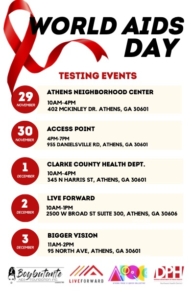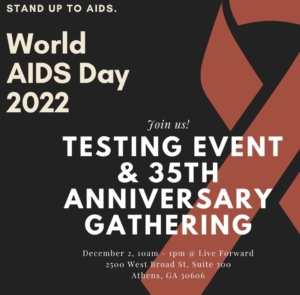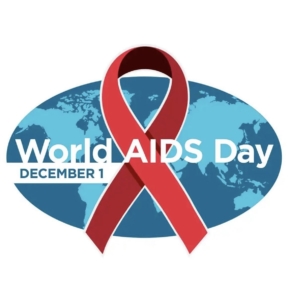News & Events




Below you will find more information on COVID-19.
What is COVID-19
- Coronavirus disease 2019 (COVID-19) is a respiratory illness that can spread from person to person. The virus that causes COVID-19 is a novel coronavirus that was first identified during an investigation into an outbreak in Wuhan, China. The virus has now affected many parts of the world including the United States.
Symptoms of COVID-19
- The following symptoms can range from mild to severe and may appear 2-14 days after exposure
- Fever
- Cough (usually dry)
- Shortness of breath/Difficulty breathing
Difference between COVID-19 and the Flu
- They’re different strains of viruses
- COVID-19 is a new disease caused by a new coronavirus that has not previously been seen in humans
- Adults make up most of the known cases to date.
- Older adults and people who have severe underlying chronic medical conditions like heart or lung disease or diabetes seem to be at higher risk for developing more serious complications from COVID-19 illness. Please consult with your health care provider about additional steps you may be able to take to protect yourself.
- According to the CDC, HIV and AIDS is listed as an underlying medical condition that may increase the risk of serious COVID-19 for individuals of any age.
- Clean your hands often with soap and water for AT LEAST 20 seconds especially after you’ve been in a public place or after blowing your nose, coughing, or sneezing
- Use hand sanitizer that contains AT LEAST 60% alcohol
- Avoid touching your eyes, nose, and mouth with unclean/unwashed hands
- Avoid close contact with people who are sick
- STAY HOME if you may have symptoms
- Practice social distancing: This means deliberately increasing the physical distance between yourself and other people.
- Put distance between yourself and other people if COVID-19 is spreading in your community. This is especially important for people who are at higher risk of getting very sick.
- There is currently no vaccine to prevent coronavirus disease 2019 (COVID-19).
- The best way to prevent illness is to avoid being exposed to this virus.
- The virus is thought to spread mainly from person-to-person.
- Between people who are in close contact with one another (within about 6 feet).
- Through respiratory droplets produced when an infected person coughs or sneezes.
- These droplets can land in the mouths or noses of people who are nearby or possibly be inhaled into the lungs.
- Take steps to protect others:
- Stay home if you’re sick
- Stay home if you are sick, except to get medical care.
- Cover coughs and sneezes
- Cover your mouth and nose with a tissue when you cough or sneeze or use the inside of your elbow.
- Throw used tissues in the trash.
- Immediately wash your hands with soap and water for at least 20 seconds. If soap and water are not readily available, clean your hands with a hand sanitizer that contains at least 60% alcohol.
Wear a facemask if you are sick
- If you are sick: You should wear a facemask when you are around other people (e.g., sharing a room or vehicle) and before you enter a healthcare provider’s office. If you are not able to wear a facemask (for example, because it causes trouble breathing), then you should do your best to cover your coughs and sneezes, and people who are caring for you should wear a facemask if they enter your room.
- If you are NOT sick: You do not need to wear a facemask unless you are caring for someone who is sick (and they are not able to wear a facemask). Facemasks may be in short supply and they should be saved for caregivers.
Clean and disinfect
- Clean AND disinfect frequently touched surfaces daily. This includes tables, doorknobs, light switches, countertops, handles, desks, phones, keyboards, toilets, faucets, and sinks.
- If surfaces are dirty, clean them: Use detergent or soap and water prior to disinfection.
- To disinfect:
- Most common EPA-registered household disinfectants will work. Use disinfectants appropriate for the surface.
- Options include:
- Diluting your household bleach.
- To make a bleach solution, mix: 5 tablespoons (1/3rd cup) bleach per gallon of water OR 4 teaspoons bleach per quart of water. Follow manufacturer’s instructions for application and proper ventilation. Check to ensure the product is not past its expiration date. Never mix household bleach with ammonia or any other cleanser. Unexpired household bleach will be effective against coronaviruses when properly diluted.
- Alcohol solutions.
- Ensure the solution has at least 70% alcohol.
- Other common EPA-registered household disinfectants.
- Products with EPA-approved emerging viral pathogens pdf icon[7 pages]external icon claims are expected to be effective against COVID-19 based on data for harder to kill viruses. Follow the manufacturer’s instructions for all cleaning and disinfection products (e.g., concentration, application method and contact time, etc.).
What you shouldn’t do
*According to the World Health Organization,the following measures ARE NOT effective against COVID-19 and can be harmful*
- Smoking
- Wearing multiple masks
- Taking antibiotics
- Antibiotics do not work against viruses. They only work on bacterial infections, so antibiotics WILL NOT work on COVID-19 and should not be used as a means of prevention or treatment.
What to do if you are sick
- Stay home except to get medical care.
- People who are mildly ill with COVID-19 can recover at home. Avoid public areas.
- Stay in touch with your doctor. Call before you get medical care. Be sure to get care if you feel worse or you think it is an emergency.
- Avoid public transportation, ride-sharing, or taxis.
- Separate yourself from other people in your home.
- Stay away from others by staying in a “sick room” and away from other people in your home. Use a separate bathroom, if available.
- Limit contact with pets and animals, just like you would around other people.
- Note: Although there have not been reports of pets or other animals becoming sick with COVID-19, it is still recommended that people with the virus limit contact with animals until more information is known.
- Call ahead before visiting your doctor.
- If you have a medical appointment, call your doctor’s office or emergency department, and tell them you have or may have COVID-19. This will help the office protect themselves and other patients.
- Wear a facemask if you are sick.
- You should wear a facemask when you are around other people and before you enter a healthcare provider’s office.
- If the person who is sick is not able to wear a facemask, then people who live in the home should stay in a different room. When caregivers enter the room of the sick person, they should wear a facemask. Other visitors are not recommended.
- Cover your coughs and sneezes.
- Cover your mouth and nose with a tissue when you cough or sneeze.
- Dispose of used tissues in a lined trash can.
- Immediately wash your hands with soap and water for at least 20 seconds. If soap and water are not available, use an alcohol-based hand sanitizer that contains at least 60% alcohol.
- Wash your hands often with soap and water for at least 20 seconds. This is especially important after blowing your nose, coughing, or sneezing, going to the bathroom, and before eating or preparing food.
- Avoid touching your eyes, nose, and mouth with unwashed hands.
- Avoid sharing personal household items.
- Do not share dishes, drinking glasses, cups, eating utensils, towels, or bedding with other people in your home.
- After using these items, wash them thoroughly with soap and water or put in the dishwasher.
- Clean all “high-touch” surfaces everyday.
- Routinely clean and disinfect phones, remote controls, counters, tabletops, doorknobs, bathroom fixtures, toilets, keyboards, tablets, and bedside tables.
- Clean and disinfect areas that may have blood, stool, or body fluids on them.
- Seek medical attention, but call first.
- Wear a facemask or try to keep a safe distance from other people (at least 6 feet away).
- Follow care instructions from your healthcare provider and local health department.
- How to discontinue home isolation.
- People with COVID-19 who have home isolated can stop under the following conditions:
- You have had no fever for at least 72 hours (3 full days of no fever and no medicine).
- Other symptoms (cough, shortness of breath).
- At least 7 days have passed since your symptoms first appeared.
- You received two negative tests in a row, 24 hours apart.
Testing
- When should you get tested?
- Healthy individuals are recommended to stay home if they have mild symptoms of a possible viral infection and quarantine for at least 7 days following the illness
- People under the age of 5, 65 and older, or those with underlying medical issues (such as high blood pressure, heart disease, diabetes, etc.) should seek out testing and healthcare services even if the symptoms are mild
- CDC recommends if you do believe you have the virus and wish to use healthcare services, to contact you primary care physician or clinic before going
Managing Stress and Anxiety
- Stress and Coping
- The outbreak of coronavirus disease 2019 (COVID-19) may be stressful for people. Fear and anxiety about a disease can be overwhelming and cause strong emotions in adults and children. Coping with stress will make you, the people you care about, and your community stronger.
- Everyone reacts differently to stressful situations. How you respond to the outbreak can depend on your background, the things that make you different from other people, and the community you live in.
- People who may respond more strongly to the stress of a crisis include
- Older people and people with chronic diseases who are at higher risk for COVID-19
- Children and teens
- People who are helping with the response to COVID-19, like doctors and other health care providers, or first responders
- People who have mental health conditions including problems with substance use
- Stress during an infectious disease outbreak can include
- Fear and worry about your own health and the health of your loved ones
- Changes in sleep or eating patterns
- Difficulty sleeping or concentrating
- Worsening of chronic health problems
- Increased use of alcohol, tobacco, or other drugs
- People with preexisting mental health conditions should continue with their treatment and be aware of new or worsening symptoms. Additional information can be found at the Substance Abuse and Mental Health Services Administration.
- Taking care of yourself, your friends, and your family can help you cope with stress. Helping others cope with their stress can also make your community stronger.
- Things you can do to support yourself
- Take breaks from watching, reading, or listening to news stories, including social media. Hearing about the pandemic repeatedly can be upsetting.
- Take care of your body. Take deep breaths, stretch, or meditate. Try to eat healthy, well-balanced meals, exercise regularly, get plenty of sleep, and avoid alcohol and drugs.
- Make time to unwind. Try to do some other activities you enjoy.
- Connect with others. Talk with people you trust about your concerns and how you are feeling.
- Reduce stress in yourself and others
- Sharing the facts about COVID-19 and understanding the actual risk to yourself and people you care about can make an outbreak less stressful.
- When you share accurate information about COVID-19 you can help make people feel less stressed and allow you to connect with them.
- For parents
- Children and teens react, in part, on what they see from the adults around them. When parents and caregivers deal with the COVID-19 calmly and confidently, they can provide the best support for their children. Parents can be more reassuring to others around them, especially children, if they are better prepared.
- Not all children and teens respond to stress in the same way. Some common changes to watch for include:
- Excessive crying or irritation in younger children
- Returning to behaviors they have outgrown (for example, toileting accidents or bedwetting)
- Excessive worry or sadness
- Unhealthy eating or sleeping habits
- Irritability and “acting out” behaviors in teens
- Poor school performance or avoiding school
- Difficulty with attention and concentration
- Avoidance of activities enjoyed in the past
- Unexplained headaches or body pain
- Use of alcohol, tobacco, or other drugs
- There are many things you can do to support your child:
- Take time to talk with your child or teen about the COVID-19 outbreak. Answer questions and share facts about COVID-19 in a way that your child or teen can understand.
- Reassure your child or teen that they are safe. Let them know it is ok if they feel upset. Share with them how you deal with your own stress so that they can learn how to cope from you.
- Limit your family’s exposure to news coverage of the event, including social media. Children may misinterpret what they hear and can be frightened about something they do not understand.
- Try to keep up with regular routines. If schools are closed, create a schedule for learning activities and relaxing or fun activities.
- Be a role model. Take breaks, get plenty of sleep, exercise, and eat well. Connect with your friends and family members.
Create a household plan of action
- Talk with the people who need to be included in your plan. Meet with household members, other relatives, and friends to discuss what to do if an outbreak occurs in your community and what the needs of each person will be.
- Plan ways to care for those who might be at greater risk for serious complications.
- Get to know your neighbors. Talk with your neighbors about emergency planning. If your neighborhood has a website or social media page, consider joining it to maintain access to neighbors, information, and resources.
- Identify aid organizations in your community. Create a list of local organizations that you and your household can contact in the event you need access to information, healthcare services, support, and resources.
Create an emergency contact list. Ensure your household has a current list of emergency contacts for family, friends, neighbors, carpool drivers, healthcare providers, teachers, employers, the local public health department, and other community resources.



